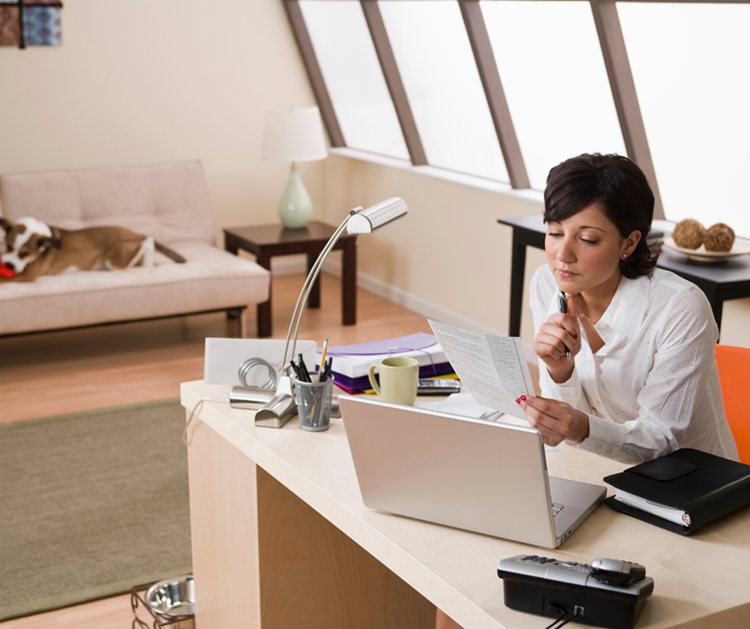Home office "how-to's"
Tips for working at home from the Citavi team

Image: Canva.com
For many of you the past few weeks have been new territory: you might be working from home for the first time ever or at least the first time for days on end. This means a lot of new challenges. Our team at Swiss Academic Software has now switched over to working from home as well. But, for over half of our team, this was no big deal since they have already been working from home for many years. We’ve shared some of their tips below:
- Create a workspace to help you focus
Most people don’t do their best work sandwiched between a pile of laundry and the television set. It’s too easy to be distracted by the other things around and end up procrastinating. To avoid this, make sure to create a space for working. The best solution is a separate room where you can close the door. If you don’t have this luxury, try to block off a section of your apartment. Use a room divider or a curtain to section off this area so that you can focus. If necessary, to keep chaotic, messy areas out of view, cover them up with a sheet while you’re working. - Set clear signals that you’re working
It’s difficult for both you and your family when you’re working from home. Physically, you’re there, but you aren’t able to interact with your loved ones. A closed door sets a clear signal: don’t disturb me, I’m working. You can use other signals, too, for example, leaving your headset on or wearing a name tag on your business shirt or blouse to show which role you are currently in. That helps both your family and you. As soon as you’re working, your job duties take precedent and you can better transition into this role, even if you’re still in your home environment. - Look the part
You may have raised your eyebrows when a business shirt or blouse were mentioned above. If you don’t need to leave the house, you could of course skip wearing more formal clothes. However, we’ve tried working in pajamas, and unfortunately have to concur that clothes make the man (or woman). Because you associate your PJs or sweatpants with relaxing, it’s much harder to motivate yourself to work. For this reason, we recommend dressing similarly to how you would if you were going to work. Of course, if you usually wear a suit, you can probably dress a little less formally while at home – comfort is important, too! - Get going properly
The snooze button is even more tempting if your commute only takes 10 steps instead of a half hour. However, stumbling out of bed and over to your desk isn’t the best way to start your day, in our experience. Instead, try to keep up a similar routine to that you had before: eat breakfast, get dressed, and, if you can, create an artificial commute, for example, walk your dog. These rituals can help mentally prepare you to shift into work mode. - Minimize distractions
If you are sitting at home in front of the computer and want to know what’s going on outside in the rest of the world, news sites or social media can be a big temptation. At home there’s no social control from your work colleagues as there would be in the office. Make sure to block any pages that could distract you on your work computer. If your smartphone is the bigger distraction, these tips from a past blog post can help you focus better. - Don’t forget to shut off
There’s a stigma that productivity suffers when people work from home. However, the opposite is often the case! In the office a chatty colleague coming back from lunch can rip you out of your flow. But at home, you can concentrate for hours on end without interruption. The disadvantage is that it’s harder to „shut off“ from your work and recognize when you’ve done enough. Set an alarm clock to remind yourself when your workday is over, and your personal time should begin. To transition away from work, it can help to have a ritual, such as making a cup of tea and taking a few minutes to drink it and stare out of the window. - Move around
It’s unfortunately the case that when you work at home, you’ll move a lot less. Since you’re no longer physically going to the office or walking around in your workplace, your daily step count can suffer. This makes it important to get some exercise in your breaks or after the workday has ended. - Maintain contact
Communication over alternative channels is very important when working from home, but it takes more effort than in the office, since you can’t just walk over to your colleague’s desk to ask a question or get important updates around the water cooler. For this reason, our company has daily group video calls for different departments. One-on-one talks are also done as video calls. This makes the distance seem a little less far and keeps team morale alive even when everyone is physically located in different places.
We hope that these tips will help make your transition to working from home a little easier. We wish you the best of luck and good health.
Which tips would you add to our list? What do you find most difficult about working from home? We’d love to hear about your experiences on our Facebook page.


